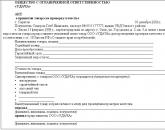How to write an explanatory note at work - basic requirements
People tend to make mistakes. In order to mitigate the punishment of the authorities as much as possible or avoid it altogether, the author must be able to correctly express his thoughts in an explanatory document and give logical arguments. It is from a well-designed "exculpatory" note that further success and career advancement depend.
Most often, the initiators of the preparation of this document, according to labor relations, are the higher management of the organization, departmental and non-departmental employees, as well as law enforcement representatives in the implementation of other relations.
Concept and essence
A written explanation refers to a type of memo that may contain an explanation of the causes of an incident, fact or act. It may accompany the main document and include an explanation of individual provisions. The employer must have good reasons to demand it from the employee. For example, violation of official and labor obligations by an employee.
It is required by the Labor Code of the Russian Federation to assess the respectfulness of a violation of a disciplinary order. Depending on the circumstances, for an employee, a disciplinary sanction may result in a reprimand, a reprimand, or dismissal from work.
The main task of this document is to convey to the authorities all the arguments and the employee's vision of the ongoing incident. With its help, it is possible to conduct an internal investigation of what is happening, to understand the details and draw the appropriate conclusions. Often, a correctly drawn up form allowed the employee to justify himself and get another chance.
Writing an appeal correctly is not as difficult as it seems at first glance. All "guide" notes in all companies, enterprises and organizations are compiled in accordance with requirements of GOST R6.30 - 2003. The only exception is written content, since it is not regulated by any. But still, before writing, you need to make sure that this enterprise does not have its own requirements for text and design.
Types of explanatory notes: causes
- Exculpatory character. It is issued if the employee fully agrees with the commission of a personal negative act (inaction or action).
- explanatory character. It is drawn up in those cases when it is necessary to indicate the conditions and circumstances of the incident that occurred due to the actions and will of the employee, which are not dependent on the actions and will of the employee, as well as an indication of the commission of acts by third parties.
Who has the right to claim?
According to the current legislation and the functioning provisions of the Labor Code of the Russian Federation, the employee is obliged to write a "guide" in the event that this was required by the management.
The one who requires writing a written explanation must hold the position of the head of the company or be an authorized person approved by special order for the enterprise for a certain period of time.
Writing Requirements
- Business style of presentation, lack of profanity, colloquial vocabulary.
- Brevity of presentation, reliability of the information presented.
- The document is written in the first person.
- At the end, a personal signature and the date of writing must be affixed.
In practice, each employee independently draws up a document in one copy. The written form is written in the name of the head of the enterprise (higher management) and drawn up on a sheet of A4 paper.
It is important to know that an explanatory note is completely different than a statement or report. In it, the employee does not state anything, does not demand that the manager consider any incident, does not describe his personal opinion, but only reflects the incident that happened.
As an example, examples related to absenteeism, being late for the workplace, failure to fulfill direct official obligations, failure to complete tasks, as well as violation of deadlines, etc. can serve as an example.
How to write?
An explanatory note is a confirmation by an employee of his guilt in writing. Therefore, before compiling it, you should carefully read your rights and obligations. However, you should not get too carried away, as there is a risk of spoiling your relationship with your superiors and your career.
It is better when the culprit is printed on a computer, since illegible underlining can be harmful if you have to deal with an incident on a labor dispute commission:
- In the upper right corner, indicate the name of the head or other official to whom you are submitting the explanation.
- Below, under the address, indicate your name and position.
- In the center, indicate the name of the document: "Explanatory".
- In the main part of your explanatory note, there is a statement of specific facts that led to situations requiring clarification.
- At the very end, put down the date of submission of the document and your personal signature.
The perpetrator of the appeal should be accurate in indicating the date and time of the incident, as well as in indicating any actions he committed, their legality and what he was guided by when making his decision. It can also be pointed out that the author acted in this way precisely because the situation demanded it, or perhaps he was not involved in it at all. Such an approach can soften the perception of the committed acts in the eyes of the one who will be decisive in this matter.
Before you start writing, you can view samples of finished documents on the Internet. The finished note is submitted for consideration to the management of the enterprise or an authorized person, where he puts down a resolution regarding the culprit of the situation that happened, indicating further actions. If the employer decides to bring the employee to disciplinary action, the explanatory note is attached to the case as evidence.
Higher authorities must give 2 days to write an appeal, so you don't have to start writing right away. At this time, the initiator can consult with lawyers, colleagues regarding the current situation. It will also help you calm down and look at what happened more realistically. After all, it is on its basis that the higher authorities will decide on the collection of a fine, lowering the level of the position, or removing the citizen with dismissal due to inconsistency with the position held.

Main Cases
If the perpetrator believes that there was nothing reprehensible in his actions, he has the right to refuse to write an explanatory note. This opportunity is given on the basis of Article 193 of the Labor Code of the Russian Federation, which states that the management cannot assess the refusal to write a note as a disciplinary violation.
We must not forget that in such a situation there is a great risk of permanently ruining your relationship with the heads of the enterprise, and posing a big question of promotion.
In addition, the management also has the right to draw up an appropriate act on the refusal to write a document.
Even in this case, the employee can be fired:
- Explanatory note to school.
- Explanatory note about non-fulfillment of the plan.
- Explanatory note to the tax office.
- Explanatory note for being late.
- Explanatory note about absenteeism.
- Explanatory note of the cashier.
The authorities, realistically assessing the incident, decide on a legitimate measure of disciplinary action, and whether it should be taken in a particular situation. When expressing your thoughts, you should not mislead the leadership, so the truth will still become known and turn against the author.
The exculpatory nature of the presentation will not give anything, so it is worth describing situations from the outside and without emotions. What happened should be described by a simple and understandable description of the facts that happened. You should not place the blame on your colleagues or other persons who may be involved in this case.
All requirements regarding the preparation of a “justifying” appeal are inalienable rules for bringing the perpetrator to the execution of disciplinary responsibility regarding his workplace and company territory. It is she who makes it possible to find out the true reasons and the situation due to which the misconduct was committed, as well as the role of the employee and the degree of his guilt.
Popular
- How to get a TIN: possible ways
- What kind of business can you do?
- Written notice of termination of the lease
- Business from scratch. Things to do?
- Cost of goods sold: formula, methodology and calculation example
- How to write a vacation application - examples
- What kind of business can be opened in a small town or village?
- The formula for calculating the cost of services, products sold and total cost
- Sample memorandum: I bring to your attention
- Example of an explanatory note for being late for work




